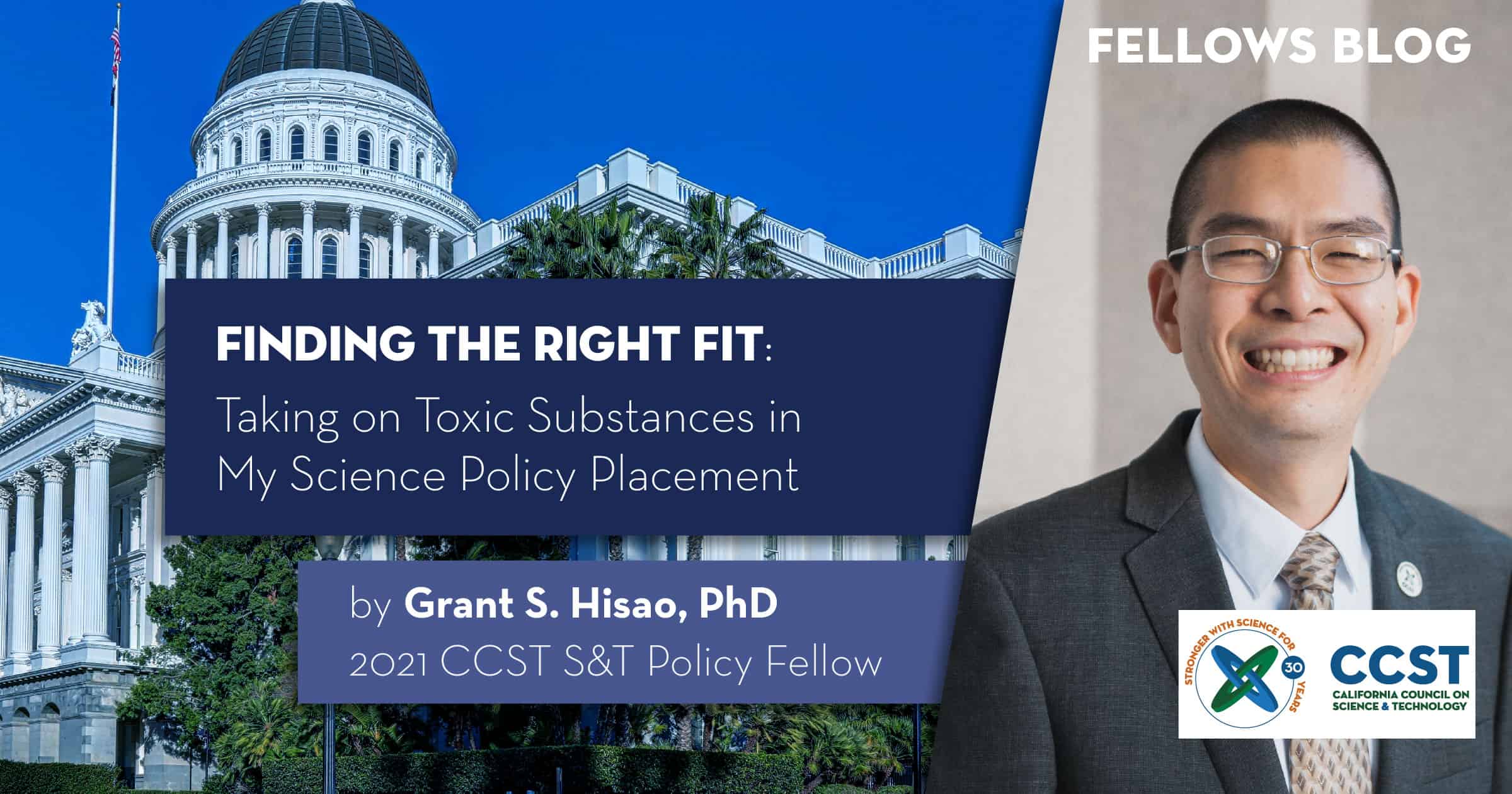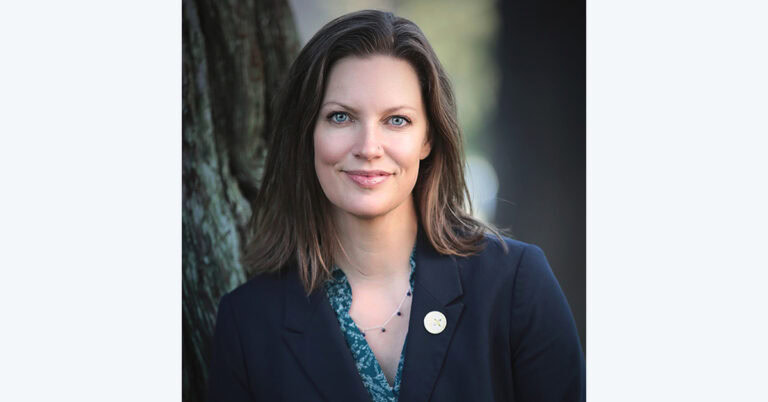Deputy Director
Finding the Right Fit: Taking on Toxic Substances in My Science Policy Placement
March 23, 2021 | CCST Newsroom, CCST S&T Policy Fellows

Grant S. Hisao is a 2021 CCST Science & Technology Policy Fellow placed with the California Department of Toxic Substances Control. Grant earned his PhD in Chemistry from the University of Illinois at Urbana-Champaign studying biological molecules associated with infectious diseases. He conducted postdoctoral research in Biochemistry at the University of Wisconsin-Madison. Grant holds a BA in Chemistry from Grinnell College. While a postdoc, he was an active member of Catalyst for Science Policy (CaSP), a science policy group at the University of Wisconsin-Madison. Furthermore, he is a member of the National Science Policy Network (NSPN) and an Associate Editor at the Journal of Science Policy and Governance.
On our first day of training as CCST S&T Policy Fellows, we pondered the many placement opportunities in the California State Legislature and Executive Branch where we would potentially be spending our Fellowship year. As we thought about it, CCST’s Executive Director Amber Mace gave us the advice to “get in where you fit in.” Since it was very early in training, I didn’t fully comprehend the meaning of her advice, but I kept it in the back of my mind throughout the rest of training and as we interviewed with each placement office. Ultimately, I came to learn the importance of this phrase through CCST’s placement process, designed to match each Fellow with an office that ‘fits’ their wide range of criteria: subject matter interest, personality, mentorship preferences, and long-term career goals, among other criteria.
Admittedly, it was a challenge for me to decide which of the many office placements best fit me. In the Executive Branch, the sheer size and number of boards, departments, offices, and agencies (BDOAs) presented us with the opportunity to explore the many facets within each office—legislative work, regulatory work, strategic planning, and more. With so many opportunities and such different areas of work, it was difficult to decide which placement I was most interested in. However, guided by my criteria for a good fit and Amber’s words of advice, I put my trust in the placement process and ultimately found the right fit.
My placement puts me into two distinct offices within DTSC, where I get to apply and learn a variety of different skills.
My Placement with DTSC
Through the matching process, I was placed at the California Department of Toxic Substances Control (DTSC), a mid-sized BDO housed under the California Environmental Protection Agency (CalEPA) of approximately 1,000 employees spread among 10 locations throughout the state. The department has three primary programs (Site Mitigation and Restoration, Hazardous Waste Management, and Safer Consumer Products) and many offices that support the department. My placement puts me into two distinct offices within DTSC, where I get to apply and learn a variety of different skills.
The Office of Legislation and Regulatory Review
The Office of Legislation and Regulatory Review (OLRR), my primary office, is a small team (10 people including myself and a CSU Executive Fellow) responsible for facilitating the rulemaking process (i.e. Regulation Development and implementation of laws), tracking and analyzing legislation during the legislative session, providing technical assistance to legislative staff (personal office and committee), and liaising between multiple entities impacted by legislation. As a member of this team, I work on drafting bill analyses, monitoring legislative hearings, and participating in stakeholder meetings. The pace of work in this office tends to be quick as it runs parallel to the legislative calendar.
Safer Consumer Products Program
My second office, in the Safer Consumer Products (SCP) Program, has a goal of reducing toxic chemicals in consumer products by investigating and regulating products that contain them. The office does this by working with industry to identify safer chemical alternatives to use during the manufacturing process and to ensure toxics don’t end up in consumer products. Furthermore, if no alternatives are available, the office has the ability to put regulations in place to curb exposure to toxic chemicals. In this office, I have a longer-term research project where I am developing a roadmap towards a new chemicals strategy that can more proactively lead the Department and State towards a toxic free future. Thus, I spend my time researching policies, conducting informational interviews with subject area experts, and brainstorming new policy ideas with my end goal being a whitepaper that would summarize my findings.
My two offices have different types of work, and function very differently from each other with distinct agendas and atmospheres. Since the SCP team is made up of many Ph.D. scientists, it has an air of familiarity from my academic background. Conversations in this office are heavily focused on science and the application of science in policy making. The office also conducts a monthly seminar series featuring experts within the toxics and environmental sectors, which is reminiscent of academia. In this office, I connect with my colleagues through our shared background in science.
On the flip side, CCST’s training on the legislative process, political aspects of California, and the overall policy culture of state government prepared me well to join OLRR, which is more in tune with the activity of the legislature and the regulatory process of the department and more broadly the CalEPA.
Meeting the Challenges of A Dual-Office Placement
While fitting-in in each office hasn’t been a challenge, managing the duality of my placement requires some additional, intentional effort. Since my duties and subject areas don’t necessarily cross over from office to office, traveling mentally between two offices has been the biggest challenge. For example, going from a meeting in SCP to a meeting in OLRR usually takes a moment to reset my mind and thought process.
This setup has taught me how to better manage my time and prioritize my duties and to communicate honestly with my mentors from both offices about my workload and expectations. I am grateful to have the encouragement of multiple mentors—including CCST S&T Policy Fellow alum Gabby Nepomuceno, PhD—who have reasonable expectations while still challenging me. The dual placement has been an opportunity for lots of personal and professional growth beyond what I would have experienced in a single office.

Exploring beyond my offices
Though I am formally placed into two offices at DTSC, my work has provided additional opportunities for outreach and collaboration. In my work at OLRR, I interact with staff in other program areas, legislative staff, and external stakeholders such as lobbyists. One of my subject areas has been the issue of treated wood waste (TWW). Pressure treated wood is generally defined as wood that has been infused with chemical preservatives to prolong the use of the material and is often used to build decks, fences, and utility poles. Since the wood is treated with toxic chemicals, spent TWW is considered hazardous waste. This topic has enabled me to work with the Hazardous Waste Management Program and to interact with stakeholders in this area.
As part of my project at SCP, I have been conducting informational interviews with individuals beyond the department. This includes experts in academia, staff members of other BDOAs, and people in local or foreign governments. While doing research on toxics in consumer products, I’ve also been able to learn more and establish connections beyond my office.
So did I get in where I fit in?
Yes I did. While all of the placement offices have something to offer, I am enjoying my experience at DTSC, the challenging work it brings, my encouraging mentors, and the many opportunities to do a variety of policy work. It has been a valuable experience and I believe it is the best fit for me.
About the CCST Science & Technology Policy Fellowship
The CCST Science & Technology Policy Fellows program trains scientific thinkers to be policy-savvy, while helping equip California’s decision makers with science-savvy staff. The program was established in 2009 with funds from the Gordon and Betty Moore Foundation and other generous friends. Discover how our CCST Science Fellows make a difference in California’s policy arena at ccst.us/ccst-science-fellows-program.




